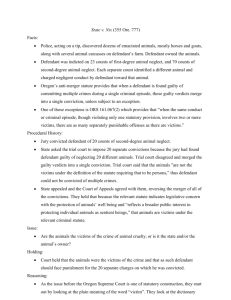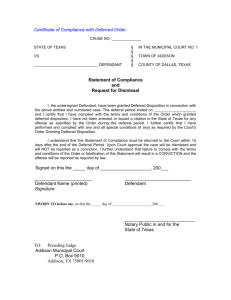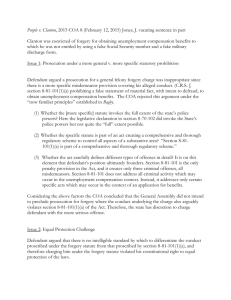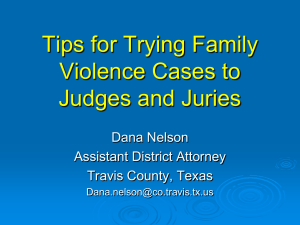2C:33-4
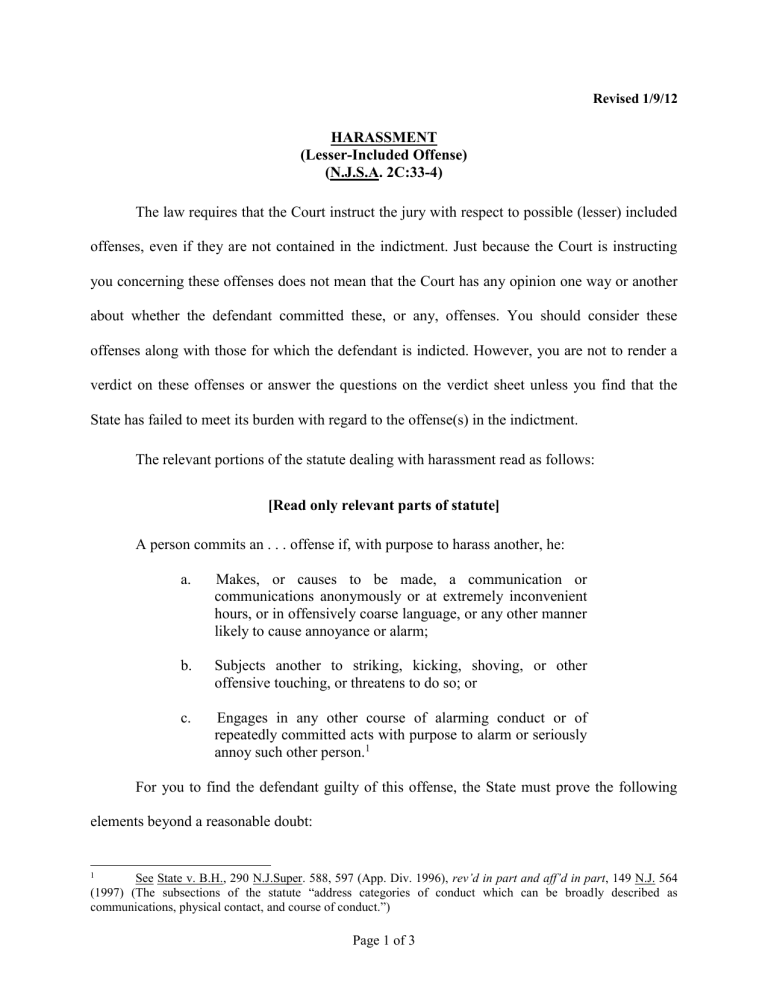
Revised 1/9/12
HARASSMENT
(Lesser-Included Offense)
(N.J.S.A. 2C:33-4)
The law requires that the Court instruct the jury with respect to possible (lesser) included offenses, even if they are not contained in the indictment. Just because the Court is instructing you concerning these offenses does not mean that the Court has any opinion one way or another about whether the defendant committed these, or any, offenses. You should consider these offenses along with those for which the defendant is indicted. However, you are not to render a verdict on these offenses or answer the questions on the verdict sheet unless you find that the
State has failed to meet its burden with regard to the offense(s) in the indictment.
The relevant portions of the statute dealing with harassment read as follows:
[Read only relevant parts of statute]
A person commits an . . . offense if, with purpose to harass another, he: a. Makes, or causes to be made, a communication or communications anonymously or at extremely inconvenient hours, or in offensively coarse language, or any other manner likely to cause annoyance or alarm; b. Subjects another to striking, kicking, shoving, or other offensive touching, or threatens to do so; or c. Engages in any other course of alarming conduct or of repeatedly committed acts with purpose to alarm or seriously annoy such other person.
1
For you to find the defendant guilty of this offense, the State must prove the following elements beyond a reasonable doubt:
1 See State v. B.H., 290 N.J.Super. 588, 597 (App. Div. 1996), rev’d in part and aff’d in part , 149 N.J. 564
(1997) (The subsections of the statute “address categories of conduct which can be broadly described as communications, physical contact, and course of conduct.”)
Page 1 of 3
HARASSMENT
(Lesser-Included Offense)
(N.J.S.A. 2C:33-4)
[Include only relevant alternative elements and related explanations] a. (1) That the defendant made one or more communications anonymously, or at
extremely inconvenient hours, or in offensively coarse language, or in any
other manner likely to cause annoyance or alarm; and
(2) That the defendant’s purpose was to harass (name of victim), in other
words, to annoy or alarm (name of victim).
You must determine whether the evidence proves beyond a reasonable doubt that the defendant made one or more communications in one or more of the ways described, and whether it was the defendant’s purpose to annoy or alarm (the victim).
If you find that one or more communications were made in a manner likely to cause annoyance or alarm, but that they were not made anonymously or at extremely inconvenient hours or in offensively coarse language, then the manner of communication used by the defendant must be one that intruded into the victim’s legitimate expectations of privacy from such communications.
2
OR b. (1) That the defendant threatened to (or did) 3 strike, kick, shove, or otherwise offensively touch (name of victim); and
(2) That the defendant’s purpose was to harass (name of victim), in other
words, to annoy or alarm (name of victim).
2 The Supreme Court has limited the scope of the “catch-all” provision of N.J.S.A. 2C:33-4(a) – “any other manner likely to cause annoyance or alarm” – to preserve the statute’s constitutionality. The Court held that a communication under that provision must intrude upon a legitimate expectation of privacy. State v. Hoffman, 149
N.J. 564, 583 (1997). Earlier in the same case, the Appellate Division had held that the degree of annoyance under subsection (a) must be “serious,” not merely nettlesome or vexing. State v. B.H., 290 N.J. Super. at 598. The
Supreme Court rejected this holding, noting that subsection (a) of the statute does not include the word “serious,” while subsection (c) does. See Hoffman, 149 N.J. at 575-81.
3 This model charge focuses primarily on verbal conduct because harassment is most often requested as a lesser-included offense for charges that do not involve physical contact, such as terroristic threats or stalking.
Page 2 of 3
HARASSMENT
(Lesser-Included Offense)
(N.J.S.A. 2C:33-4)
OR c. (1) That the defendant engaged in a course of alarming conduct or of
repeatedly committed acts; and
(2) That the defendant’s purpose was to harass (name of victim), that is, to
alarm or seriously annoy (name of victim).
With respect to a course of alarming conduct or repeatedly committed acts, the conduct or acts must be such that they are intended to cause alarm or serious annoyance. It is not sufficient if the course of conduct or repeated acts are merely irritating, nettlesome, or vexing.
4
A purpose to harass must be coupled with the performance of at least one of the acts listed in the statute. In determining a defendant’s purpose, you must apply the definition of the word “purpose” and the related instructions that were previously given when you were instructed regarding the elements of the offense of (terroristic threats) (stalking) as charged in the indictment. [The State alleges that the defendant’s purpose was . [
Charge where appropriate: The defendant contends that he/she did not have a purpose to harass.
Instead, he/she contends .]
If the State has failed to prove any element of harassment beyond a reasonable doubt, you must find the defendant not guilty.
On the other hand, if the State has proven each of the elements of harassment beyond a reasonable doubt, then you must find the defendant guilty of that offense.
4 The Supreme Court has limited the scope of the “catch-all” provision of N.J.S.A. 2C:33-4(a) – “any other manner likely to cause annoyance or alarm” – to preserve the statute’s constitutionality. The Court held that a communication under that provision must intrude upon a legitimate expectation of privacy. State v. Hoffman, 149
N.J. 564, 583 (1997). Earlier in the same case, the Appellate Division had held that the degree of annoyance under subsection (a) must be “serious,” not merely nettlesome or vexing. State v. B.H., 290 N.J. Super. at 598. The
Supreme Court rejected this holding, noting that subsection (a) of the statute does not include the word “serious,” while subsection (c) does. See Hoffman, 149 N.J. at 575-81.
Page 3 of 3

